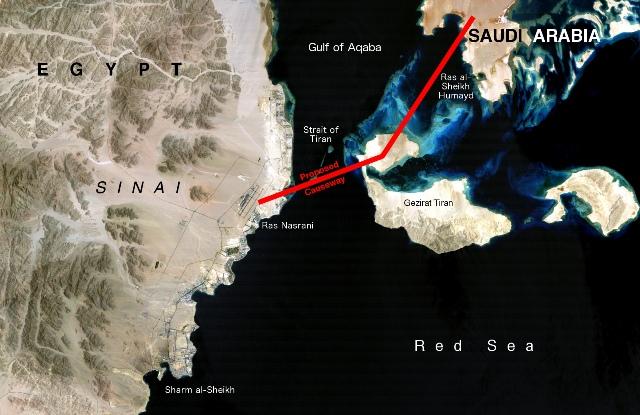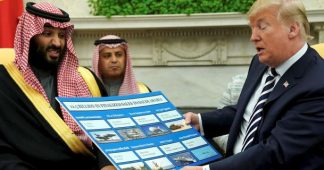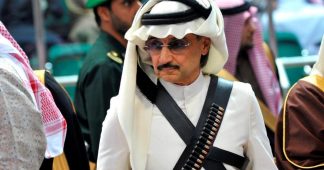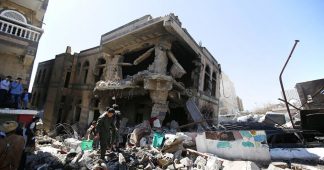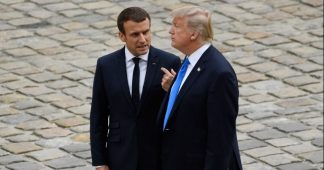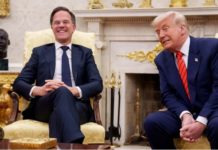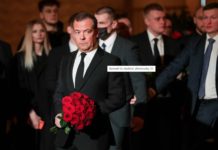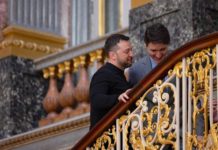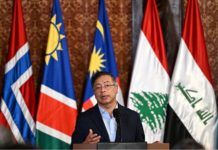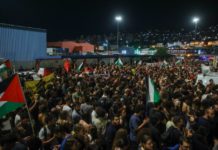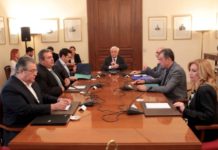With the North Korea nuclear standoff still making headlines, other nuclear-related stories – including those involving Saudi Arabia, Israel and Syria – have largely gone unnoticed, Ted Snider explains.
By Ted Snider
March 29, 2018
The past week featured two crazy nuclear stories. And neither of them involved North Korea.
Saudi Arabia
The first involved Saudi Arabia. Although this highly significant story passed almost uncovered by the media, White House officials confirmed that talks between President Donald Trump and Saudi Crown Prince Mohammed bin Salman “included critical discussions” about Saudi Arabia’s “nuclear aspirations.” Apparently, talks between Energy Secretary Rick Perry and the Saudis have been going on quietly for some time.
The crazy part isn’t that Saudi Arabia aspires to a nuclear program. Article IV of the Nuclear Non-Proliferation Treaty guarantees every country the right to a civilian nuclear program for energy and medical purposes. The crazy part also isn’t Saudi Arabia’s insistence that it would be allowed to enrich its own uranium: the same article promises that right.
The crazy part is that while Trump was continuing “to engage with our Saudi partners on their plans for a civil nuclear program and possible US supply of nuclear equipment and material,” the Crown Prince was simultaneously openly declaring Saudi Arabia’s willingness to use that aid to build a nuclear bomb. Mohammed bin Salman, also known as MBS, told a CBC interview that “Saudi Arabia does not want to acquire any nuclear bomb, but without a doubt, if Iran developed a nuclear bomb, we would follow suit as soon as possible.”
The Saudi cabinet recently passed a national policy program that limits nuclear activities to peaceful purposes. However, MBS’s open declaration shows the fragility and flexibility of that cabinet promise.
The danger in MBS’s declaration is not in the way it is formulated. It is formulated as a conditional: if Iran builds a nuclear bomb, Saudi Arabia will build a bomb. The conditional holds no danger because Iran is not building a bomb, as the International Atomic Energy Agency (IAEA) has repeatedly certified since the Joint Comprehensive Plan of Action nuclear agreement went into effect.
But there is danger in the declaration. Firstly, because Saudi Arabia claims the right to define its own terms of breaking out of the Nuclear Nonproliferation Treaty. MBS’s logic makes it clear that Saudi Arabia’s nuclear program could bleed from civilian to military if it feels threatened by an enemy of its choosing. Perhaps Iran is not building a bomb. But, what if Saudi Arabia should identify Pakistan or Israel as a threat? By the Crown Prince’s logic, that would justify using America’s “nuclear equipment and material” to build a nuclear bomb.
Secondly, the conditional takes advantage of a special American-Israeli-Saudi logic that is different than the logic found in text books. Iran never had to actually be building a bomb to suffer the sanctions and isolation of the claim that it was building a bomb. The Saudi logic, therefore, is not If Iran builds a bomb, we will build a bomb; Iran is building a bomb; therefore, we will build a bomb. Rather, it is the special and dangerous logic that if Iran builds a bomb, we will build a bomb; we claim Iran is building a bomb; therefore, we will build a bomb. In other words, the conditional justifies the breakout to nuclear weapons at any time of Saudi Arabia’s choosing.
And those are the terms under which Trump is discussing a Saudi nuclear program with Mohammed bin Salman.
Israel and Syria
The second crazy nuclear story was Israel’s announcement that it was Israel that bombed the Syrian nuclear reactor in September of 2007.
There are two parts that are crazy about the Israeli announcement. The first is that everyone always knew it was Israel who bombed the nuclear reactor. Seymour Hersh’s 2008 article that came quickly in the wake of the strike began with the words, “Sometime after midnight on September 6, 2007, at least four low-flying Israeli Air Force fighters crossed into Syrian airspace and carried out a secret bombing mission.”
The second is that it almost certainly wasn’t a nuclear reactor.
If Syria was building a nuclear reactor, Michael Hayden’s CIA knew nothing about it. And he told that to President Bush. That the CIA missed a secret nuclear program is not impossible to believe or even entirely unprecedented. What is more unbelievable is that they missed it when it was right out in the open, that their highly sophisticated satellites missed what a commercial satellite easily picked up.
A number of nontechnical features just didn’t fit the Israeli story. Seymour Hersh picked this up in his early investigative reporting of the strike, “A Strike in the Dark.” A former State Department intelligence expert told Hersh that much that one would see around a nuclear reactor was missing from the site. There was not even any security around it. Syria’s then ambassador to the United States, Imad Moustapha marveled at the same point. He wondered:
“An allegedly strategic site in Syria without a single military checkpoint around it, without barbed wire around it, without anti-aircraft missiles around it, without any sort of security surrounding it, thrown in the middle of the desert without electricity, plans to generate electricity for it, without major supply plans around it? And yet, it is supposed to be a strategic installation? And people don’t even think of it. Yesterday, in the White House presidential statement, it was stated to the letter that that was a secret location. And yet, every commercial satellite service available on earth was able to provide photos and images of this so-called secret Syrian site for the past five, six years.”
Other facts didn’t fit the Israeli narrative either. North Korean was said to have been a key helper in the construction of the secret reactor. A North Korean ship, the Al Hamed, was said by the Israelis to have delivered nuclear equipment for the reactor. But Hersh’s investigation found that neither maritime intelligence nor the ship’s transponder gave any indication that the Al Hamad had recently docked in North Korea.
But, perhaps the most telling thing is not that the CIA missed what was out in the open for commercial satellites to pick up, not that they didn’t “have any proof of a reactor – no signals intelligence, no human intelligence, no satellite intelligence,” as a former senior U.S. intelligence official who had access to the current intelligence told Hersh. What is, perhaps, more telling is that when they were provided with the intelligence, despite signing on to the Israeli narrative, they actually assessed only “low confidence” that targeted site was part of a Syrian nuclear weapons program. And they weren’t the only ones. Mohamed ElBaradei, then director-general of the IAEA, said that their “experts who have carefully analyzed the satellite imagery say it is unlikely that this building was a nuclear facility.”
The problem was that the technical questions were even bigger than these nontechnical questions. There were three topics of technical questions.
The first was the photos provided by Israel’s Mossad. There were two problems with the photographic evidence. The first was that Hayden never asked the Israelis how they got the photographs even though the CIA Director knew that at least one of the photographs had been photo-shopped to make the case more convincing, as investigative journalist Gareth Porter has reported. The second was that the CIA was provided a bunch of photographs from inside a potential nuclear reactor and a bunch of photographs of the outside of the targeted building in Syria, but “nothing that links the two,” as former UN weapons inspector Scott Ritter has pointed out.
The second set of technical problems involves the building itself. The first was that the building was the wrong size. The Israelis and the CIA claimed that the Syrian nuclear reactor was modeled on the North Korean reactor at Yongbyon. It is a type of reactor known as a gas-cooled graphite-moderated (GCGM) reactor. But the Syrian reactor didn’t fit the blueprint. Hersh pointed out this inconsistency early. He says that non-proliferation expert Jeffrey Lewis told him that “even if the width and the length of the building were similar to the Korean site, its height was simply not sufficient to contain a Yongbyon-size reactor.”
Gareth Porter’s later investigation confirmed the contradiction. Porter relied on Yousry Abushady, the top IAEA specialist on North Korean reactors. Abushady knew GCGM reactors better than anyone at the IAEA, and “the evidence he saw in the video convinced him,” Porter reports, “that no such reactor could have been under construction” in Syria. And the first reason, again, according to Abushady was “that the building was too short to hold a reactor like the one in Yongbyon, North Korea.” According to Abushady the building bombed in Syria was only “a little more than a third as tall” as the supposed North Korean archetype.
But there were other problems. The North Korean reactor required at least 20 supporting buildings, but the Syrian site had not one even though Israeli intelligence insisted that it was only a few months from being ready to operate. The reactor was supposed to be a gas-cooled reactor, but there was nothing in place to cool the gas.
Porter reports that former senior IAEA inspector Robert Kelley also pointed to a lack of facility for treating the water in the imaging. There was also no building for a spent fuel pond. However, Abushady says that every GCGM reactor ever built has a separate building to house the spent fuel pond. Building after building is missing from the imaging, but the nuclear reactor was supposed to be on the verge of going operational.
The most serious set of problems is the third: the environmental inconsistencies. There were two damning environmental inconsistencies – the first to do with uranium and the second to do with graphite.
If the bombed Syrian building was a nuclear reactor, there should have been uranium in the environmental samples the IAEA took. But there wasn’t. Mohamed ElBaradei said that “so far, we have found no indication of any nuclear material.” Every sample that was actually taken from the ground in the area of the Syrian building tested negative for uranium and plutonium. That’s a problem for the Israeli narrative.
But, it wasn’t even the biggest problem. The biggest environmental inconsistency came not from testing for uranium but for graphite. After all, the Syrian site was supposed to be a gas-cooled graphite-moderated reactor. If it was, then when the building exploded, it should have sent graphite everywhere, according to Scott Ritter.
Ritter says there would have been thousands of pounds of graphite in the facility already. But, he says, “there’s no evidence in the destruction. … If it had been bombed and there was graphite introduced, you would have a signature all over the area of destroyed graphite blocks. There would be graphite lying around, etc. This was not the case.”
According to Porter, this inconsistency is what bothered Abushady the most too. He says the bombing of the reactor “would have spread particles of nuclear-grade graphite all over the site.” But none of the samples taken by the IAEA showed even a trace of graphite: graphite that would have to be there and that “would have been impossible to clean it up,” as nuclear expert Behrd Nakhai told Porter. Abushady says that “these results are the basis to confirm … that the site cannot [have been] actually a nuclear reactor.”
So, North Korea did not even feature in the craziest nuclear stories of the past few days. The craziest stories featured Saudi Arabia and the States and Israel and Syria: the nuclear weapons program that the Saudis could have and the one the Syrians never did.
* Ted Snider has a graduate degree in philosophy and writes on analyzing patterns in US foreign policy and history. This article originally appeared at Antiwar.com. Reprinted with permission.
Published at https://consortiumnews.com/2018/03/29/none-of-this-months-craziest-nuclear-stories-involved-north-korea/
